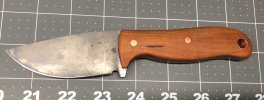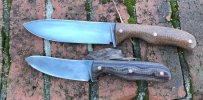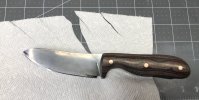ScarFoot
Knifemaker / Craftsman / Service Provider
- Joined
- Sep 16, 2021
- Messages
- 863
Sorry if this has been asked before. I tried the search function but didn’t quite find what I’m looking for.
I just started making knives this year and the bug has bitten me pretty hard to say the least. A big hurdle I’m working through is what to do with the blades when I’m ready to call them done. I’ve been experimenting with forced patinas and hamon/differential heat treating lines on multiple steels but the finish ends up being hit or miss. Sometimes they turn out and sometimes they get that orange peel look. I’ve had good luck with the knives I’ve put a patina on resisting corrosion so far but now people are starting to want them and I drive myself half crazy over minute details so I want the finish to look nice.
So, my question is, do y’all force patinas, coat with oil or wax, sand it down and call it good, etc? I know it seems simple but I’m stuck here… How do you finish them???
Below are before and after shots of a little skinner I made and processed a deer with a few weeks ago. I used it for the entire process and just wiped it off when I got done. I haven’t oiled it yet and it certainly looks used but there isn’t any rust on it. It wasn’t pretty to start with but at least it only got uglier in a good way..


I just started making knives this year and the bug has bitten me pretty hard to say the least. A big hurdle I’m working through is what to do with the blades when I’m ready to call them done. I’ve been experimenting with forced patinas and hamon/differential heat treating lines on multiple steels but the finish ends up being hit or miss. Sometimes they turn out and sometimes they get that orange peel look. I’ve had good luck with the knives I’ve put a patina on resisting corrosion so far but now people are starting to want them and I drive myself half crazy over minute details so I want the finish to look nice.
So, my question is, do y’all force patinas, coat with oil or wax, sand it down and call it good, etc? I know it seems simple but I’m stuck here… How do you finish them???
Below are before and after shots of a little skinner I made and processed a deer with a few weeks ago. I used it for the entire process and just wiped it off when I got done. I haven’t oiled it yet and it certainly looks used but there isn’t any rust on it. It wasn’t pretty to start with but at least it only got uglier in a good way..





